Fully Transparent and Sensitivity-Programmable Amorphous Indium-Gallium-Zinc-Oxide Thin-Film Transistor-Based Biosensor Platforms with Resistive Switching Memories
Abstract
:1. Introduction
2. Materials and Methods
2.1. Fabrication of Transducer and Sensing Units for Sensitivity-Programmable Biosensor
2.2. Characterization of Sensitivity-Programmable Biosensor
3. Results and Discussion
3.1. Resistive Coupling Effect Simulations
3.2. RS Characteristics of ITO/Ta2O5/ITO-Structured RS Memory
3.3. Electrical Characteristics of a-IGZO TFT-Based Transducer Units
3.4. pH-Sensing Characteristics of Sensitivity-Programmable Biosensor Platform
4. Conclusions
Author Contributions
Funding
Data Availability Statement
Acknowledgments
Conflicts of Interest
References
- St John, A.; Price, C.P. Existing and emerging technologies for point-of-care testing. Clin. Biochem. Rev. 2014, 35, 155–167. [Google Scholar]
- Lee, C.-S.; Kim, S.K.; Kim, M. Ion-sensitive field-effect transistor for biological sensing. Sensors 2009, 9, 7111–7131. [Google Scholar] [CrossRef] [PubMed]
- Moser, N.; Lande, T.S.; Toumazou, C.; Georgiou, P. ISFETs in CMOS and emergent trends in instrumentation: A review. IEEE Sensors J. 2016, 16, 6496–6514. [Google Scholar] [CrossRef]
- Vu, C.-A.; Chen, W.-Y. Field-effect transistor biosensors for biomedical applications: Recent advances and future prospects. Sensors 2019, 19, 4214. [Google Scholar] [CrossRef] [Green Version]
- Park, J.-K.; Cho, W.-J. Development of high-performance fully depleted silicon-on-insulator based extended-gate field-effect transistor using the parasitic bipolar junction transistor effect. Appl. Phys. Lett. 2012, 101, 133703. [Google Scholar] [CrossRef]
- Bergveld, P. Development of an ion-sensitive solid-state device for neurophysiological measurements. IEEE Trans. Biomed. Eng. 1970, 17, 70–71. [Google Scholar] [CrossRef]
- Yates, D.E.; Levine, S.; Healy, T.W. Site-binding model of the electrical double layer at the oxide/water interface. J. Chem. Soc. Faraday Trans. 1974, 70, 1807–1818. [Google Scholar] [CrossRef]
- Jang, H.-J.; Gu, J.-G.; Cho, W.J. Sensitivity enhancement of amorphous InGaZnO thin film transistor based extended gate field-effect transistors with dual-gate operation. Sens. Actuators B Chem. 2013, 181, 880–884. [Google Scholar] [CrossRef]
- Cho, S.-K.; Cho, W.-J. High-Sensitivity pH Sensor Based on Coplanar Gate AlGaN/GaN Metal-Oxide-Semiconductor High Electron Mobility Transistor. Chemosensors 2021, 9, 42. [Google Scholar] [CrossRef]
- Pullano, S.A.; Critello, C.D.; Mahbub, I.; Tasneem, N.T.; Shamsir, S.; Islam, S.K.; Greco, M.; Fiorillo, A.S. EGFET-based sensors for bioanalytical applications: A review. Sensors 2018, 18, 4042. [Google Scholar] [CrossRef] [Green Version]
- Chi, L.-L.; Choub, J.-C.; Chung, W.-Y.; Sunc, T.-P.; Hsiung, S.K. Study on extended gate field effect transistor with tin oxide sensing membrane. Mater. Chem. Phys. 2000, 63, 19–23. [Google Scholar] [CrossRef]
- Yang, C.-M.; Wang, I.-S.; Lin, Y.-T.; Huang, C.-H.; Lu, T.-F.; Lue, C.-E.; Pijanowska, D.G.; Hua, M.-Y.; Lai, C.-S. Low cost and flexible electrodes with NH3 plasma treatments in extended gate field effect transistors for urea detection. Sens. Actuators B Chem. 2013, 187, 274–279. [Google Scholar] [CrossRef]
- Das, A.; Ko, D.H.; Chen, C.-H.; Chang, L.-B.; Lai, C.-S.; Chu, F.-C.; Chow, L.; Lin, R.-M. Highly sensitive palladium oxide thin film extended gate FETs as pH sensor. Sens. Actuators B Chem. 2014, 205, 199–205. [Google Scholar] [CrossRef]
- Chien, Y.-S.; Tsai, W.-L.; Lee, I.-C.; Chou, J.-C.; Cheng, H.-C. A novel pH sensor of extended-gate field-effect transistors with laser-irradiated carbon-nanotube network. IEEE Electron Device Lett. 2012, 33, 1622–1624. [Google Scholar] [CrossRef]
- Chen, J.-C.; Chou, J.-C.; Sun, T.-P.; Hsiung, S.-K. Portable urea biosensor based on the extended-gate field effect transistor. Sens. Actuators B Chem. 2003, 91, 180–186. [Google Scholar] [CrossRef]
- Prakash, A.; Hwang, H. Multilevel cell storage and resistance variability in resistive random access memory. Phys. Sci. Rev. 2016, 1, 50–57. [Google Scholar]
- Wong, H.-S.P.; Lee, H.-Y.; Yu, S.; Chen, Y.-S.; Wu, Y.; Chen, P.-S.; Lee, B.; Chen, F.T.; Tsai, M.-J. Metal–oxide RRAM. IEEE Proc. 2012, 100, 1951–1970. [Google Scholar] [CrossRef]
- Ielmini, D. Resistive switching memories based on metal oxides: Mechanisms, reliability and scaling. Semicond. Sci. Technol. 2016, 31, 063002. [Google Scholar] [CrossRef]
- Yen, T.J.; Gismatulin, A.; Volodin, V.; Gritsenko, V.; Chin, A. All nonmetal resistive random access memory. Sci. Rep. 2019, 9, 6144. [Google Scholar] [CrossRef]
- Kumar, D.; Chand, R.A.U.; Tseng, T.Y. Metal oxide resistive switching memory: Materials, properties and switching mechanisms. Ceram. Int. 2017, 43, S547–S556. [Google Scholar] [CrossRef]
- Prakash, A.; Park, J.; Song, J.; Woo, J.; Cha, E.; Hwang, H. Demonstration of low power 3-bit multilevel cell characteristics in a TaOx-based RRAM by stack engineering. IEEE Electron Device Lett. 2014, 36, 32–34. [Google Scholar] [CrossRef]
- Russo, U.; Kamalanathan, D.; Ielmini, D.; Lacaita, A.L.; Kozicki, M.N. Study of multilevel programming in programmable metallization cell (PMC) memory. IEEE Trans. Electron Devices 2009, 56, 1040–1047. [Google Scholar] [CrossRef]
- Sze, S.M.; Li, Y.; Ng, K.K. Physics of Semiconductor Devices, 4th ed.; John Wiley & Sons: Hoboken, NJ, USA, 2021; p. 944. [Google Scholar]
- Li, J.; Huang, C.-X.; Zhang, J.-H.; Zhu, W.-Q.; Jiang, X.-Y.; Zhang, Z.-L. Temperature stress on a thin film transistor with a novel BaZnSnO semiconductor using a solution process. RSC Adv. 2015, 5, 9621–9626. [Google Scholar] [CrossRef]
- Bousse, L.; Bergveld, P. The role of buried OH sites in the response mechanism of inorganic-gate pH-sensitive ISFETs. Sens. Actuators 1984, 6, 65–78. [Google Scholar] [CrossRef] [Green Version]
- Shahriar, J.; Collins, S.; Smith, R.L. A physical model for drift in pH ISFETs. Sens. Actuators B Chem. 1998, 49, 146–155. [Google Scholar]
- Garde, A.; Alderman, J.; Lane, W. Improving the Drift and Hysteresis of the Si3N4 pH Response Using RTP Techniques. Sens. Mater. 1997, 9, 15–24. [Google Scholar]
- Chou, J.C.; Hsiao, C.N. The hysteresis and drift effect of hydrogenated amorphous silicon for ISFET. Sens. Actuators B Chem. 2000, 66, 181–183. [Google Scholar] [CrossRef]
- Bousse, L.; Van Den Vlekkert, H.H.; De Rooij, N.F. Hysteresis in Al2O3-gate ISFETs. Sens. Actuators B Chem. 1990, 2, 103–110. [Google Scholar] [CrossRef]
- Hein, P.; Egger, P. Drift behaviour of ISFETs with Si3N4-SiO2 gate insulator. Sens. Actuators B Chem. 1993, 14, 655–656. [Google Scholar] [CrossRef]
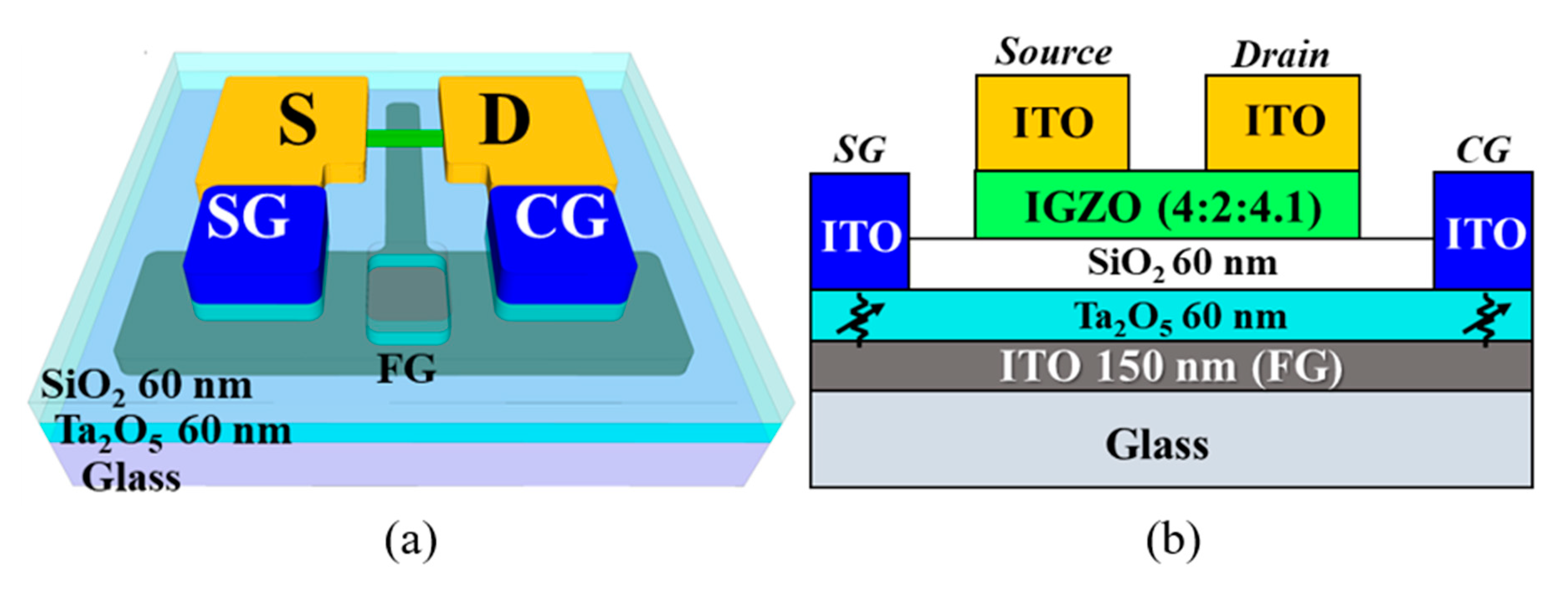
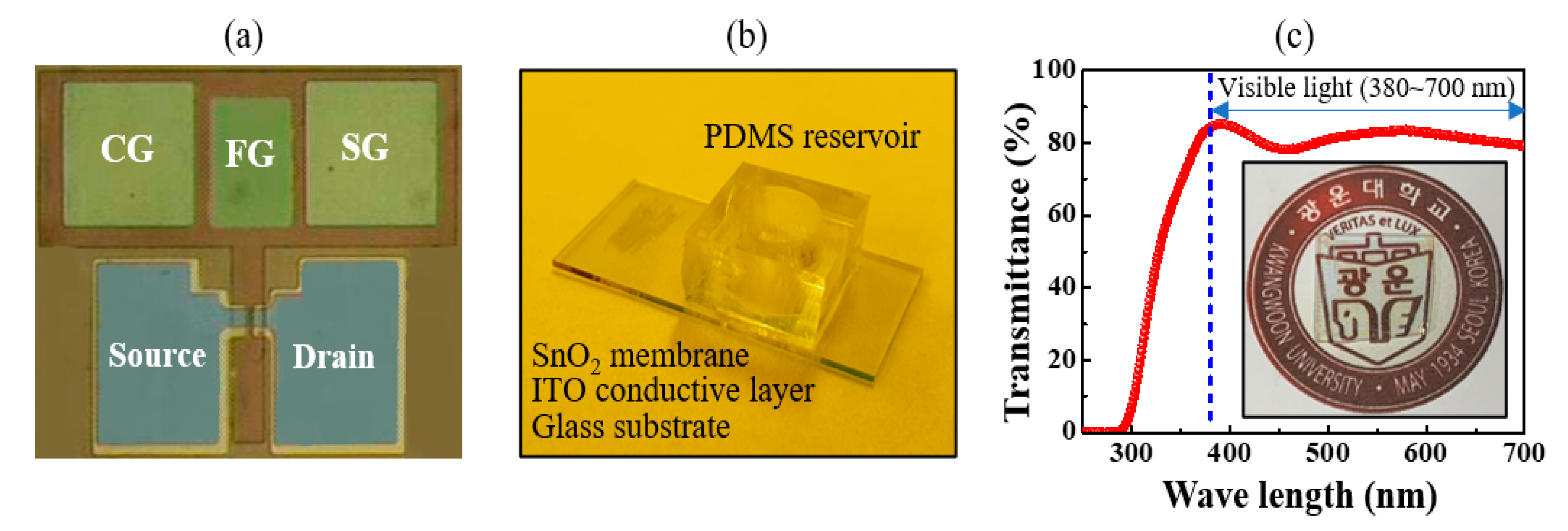
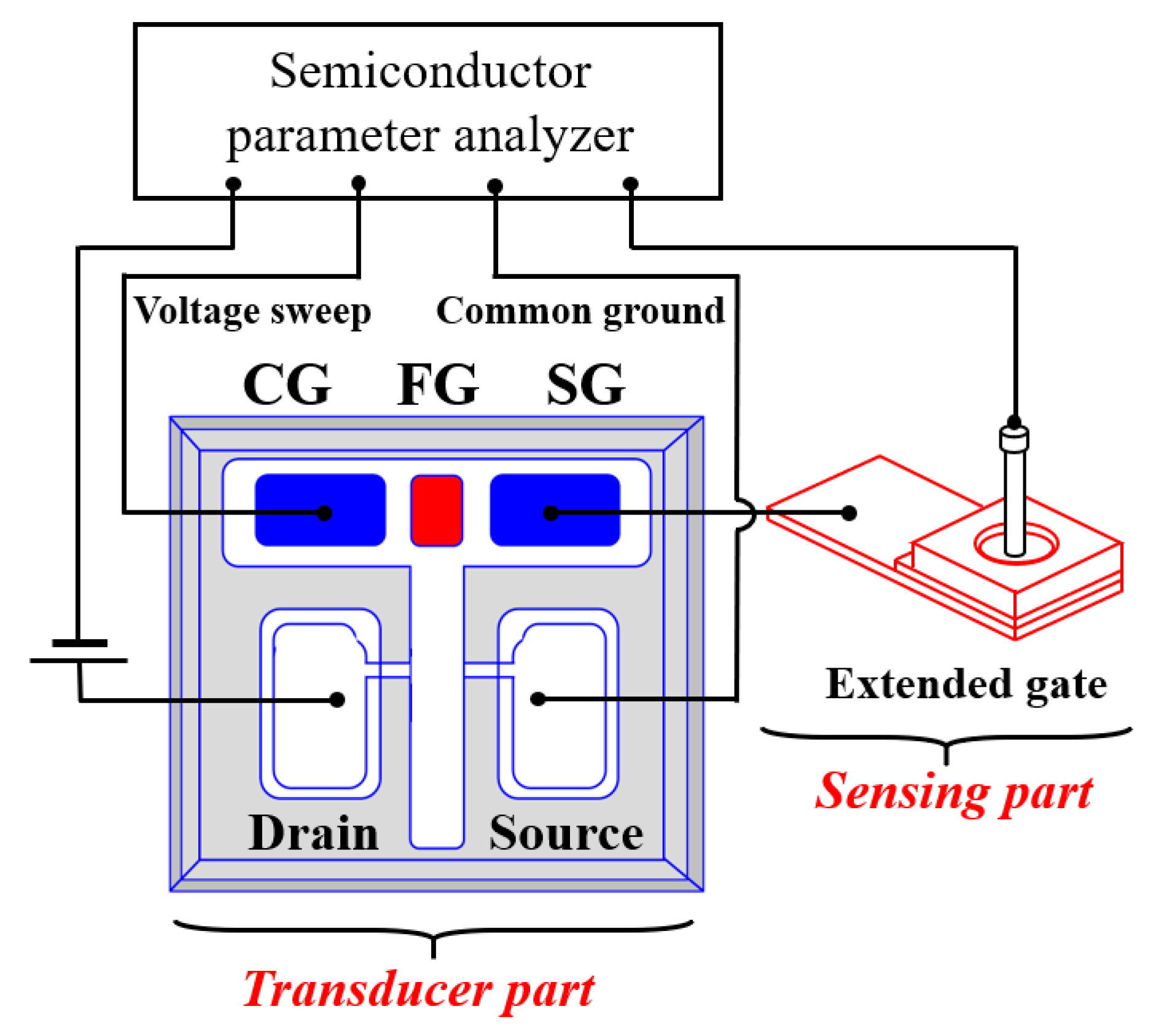
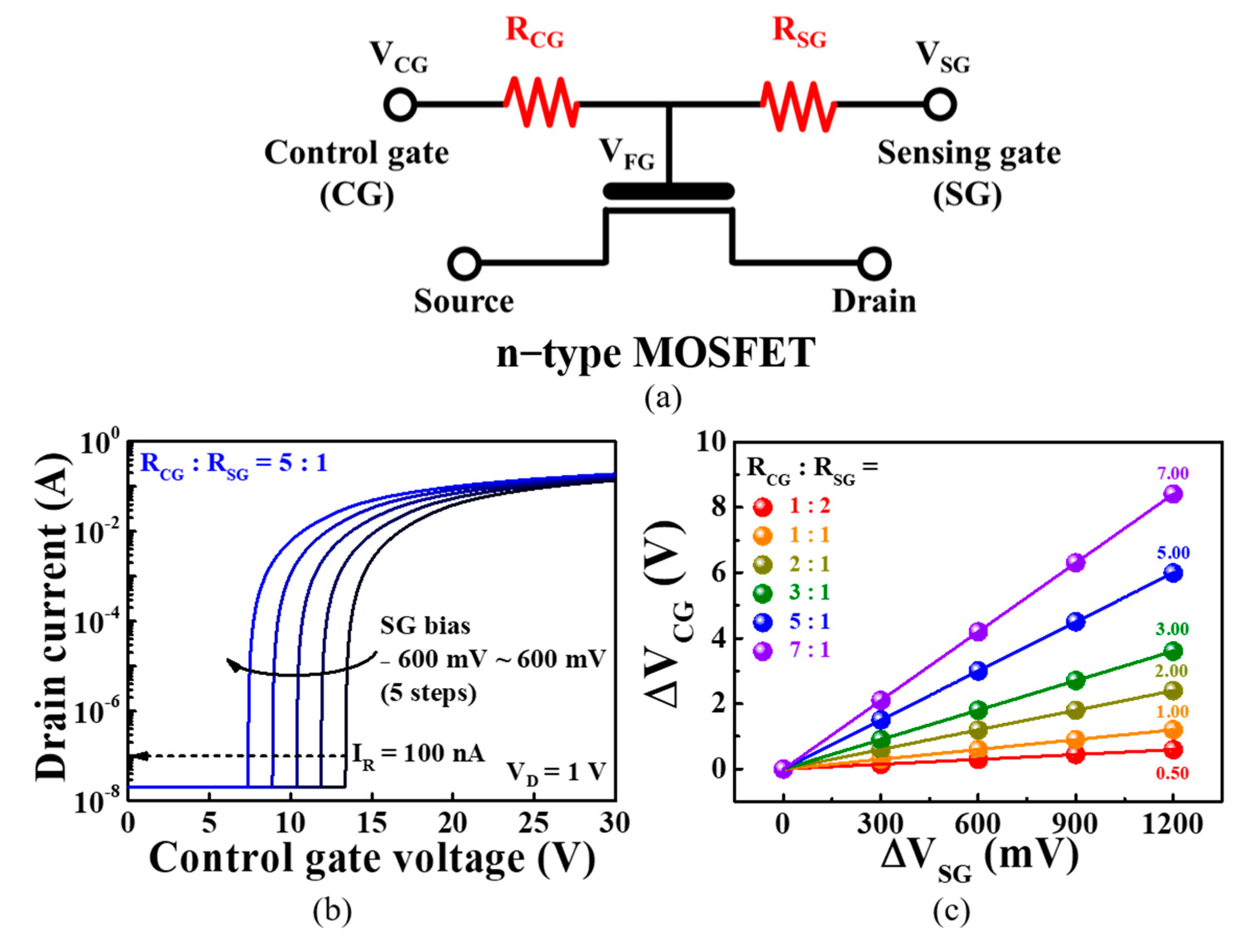
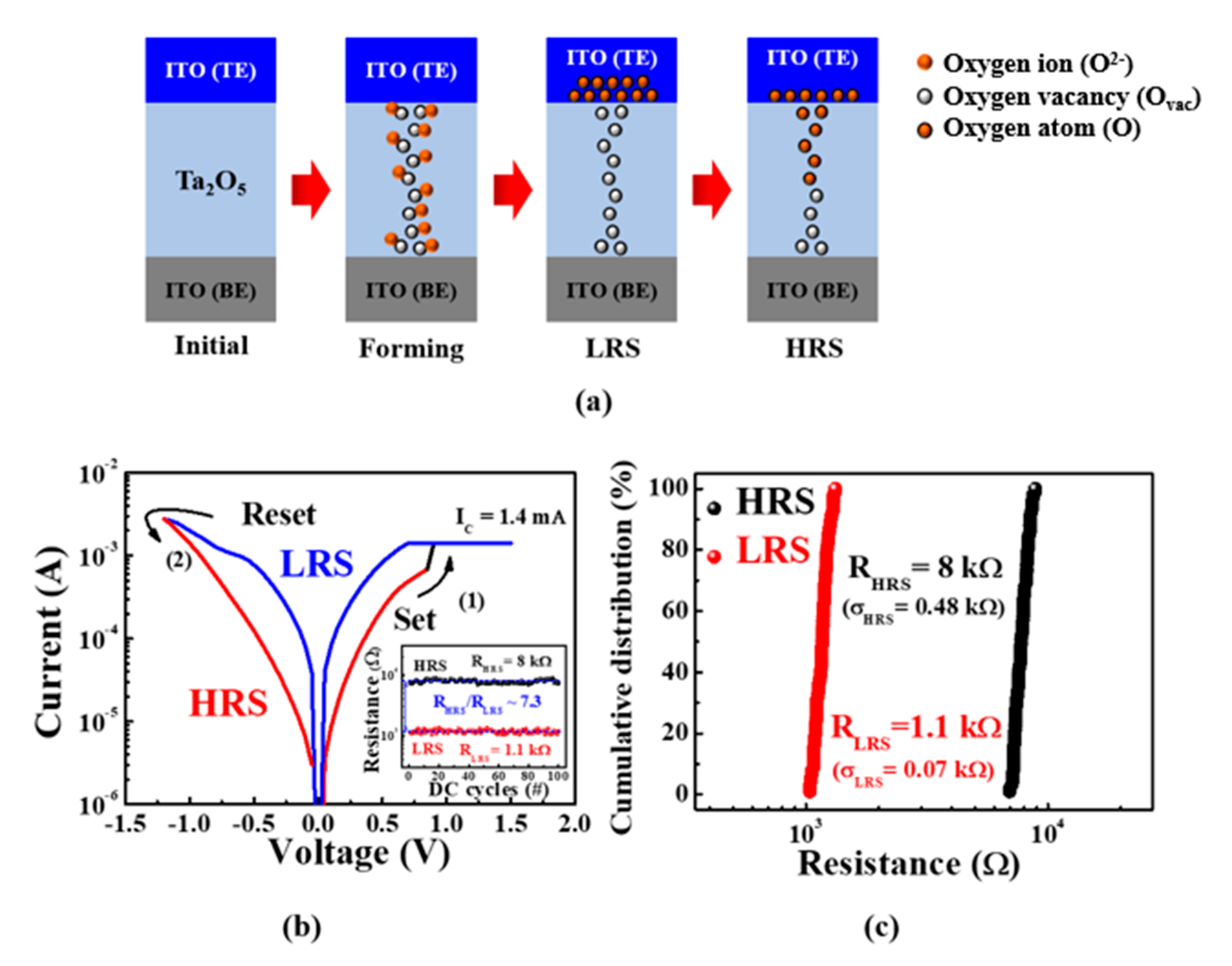

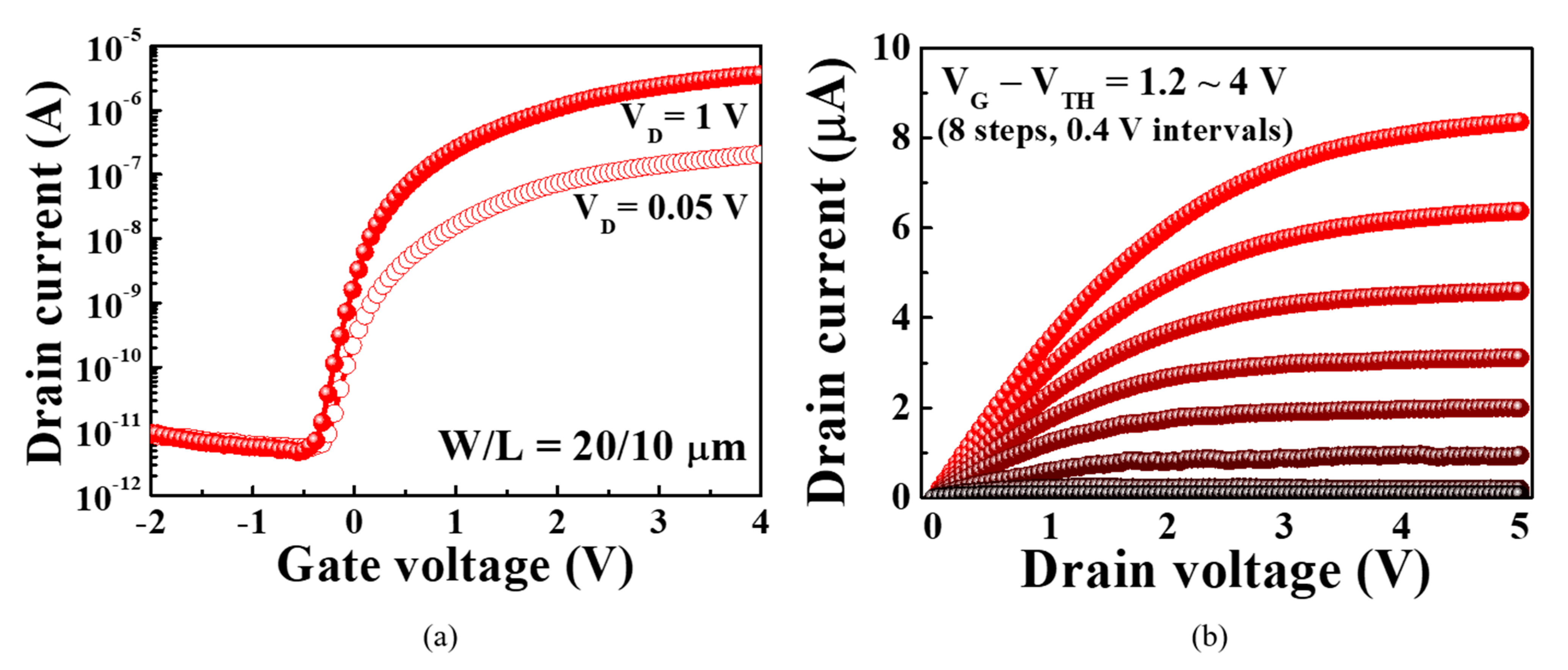
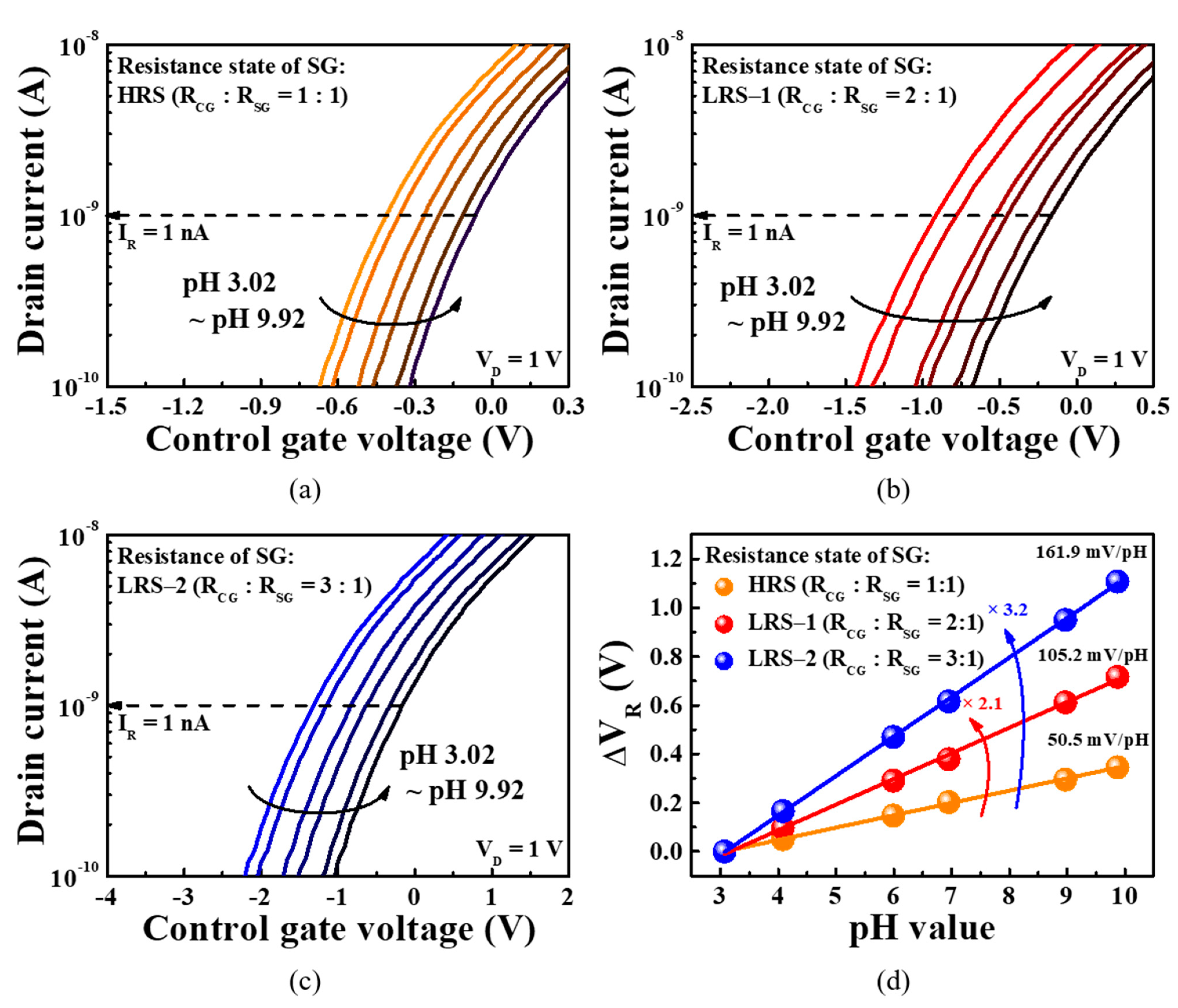
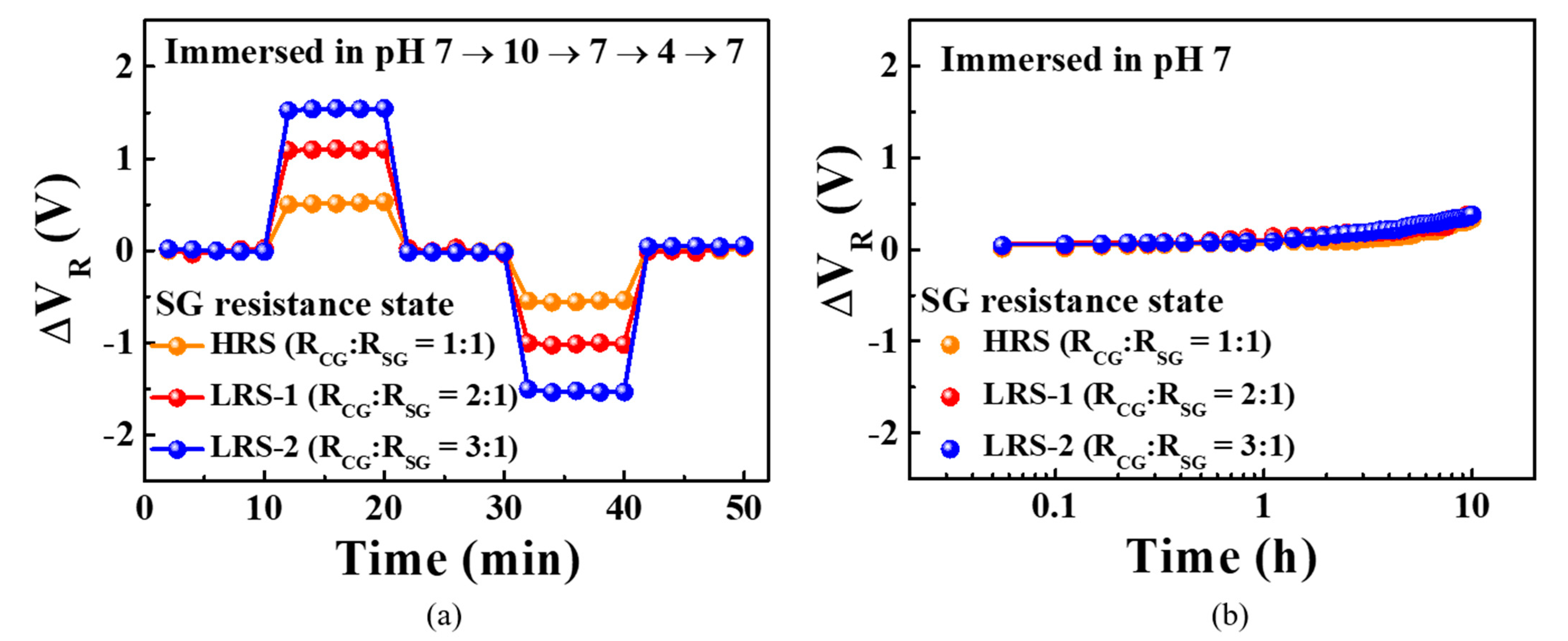
| Resistance State | R (kΩ) | σ (kΩ) |
|---|---|---|
| HRS | 7.99 | 0.30 |
| LRS-1 (IC = 0.9 mA) | 3.99 | 0.19 |
| LRS-2 (IC = 1.0 mA) | 2.63 | 0.14 |
| LRS-3 (IC = 1.1 mA) | 2.05 | 0.13 |
| LRS-4 (IC = 1.2 mA) | 1.62 | 0.13 |
| LRS-5 (IC = 1.4 mA) | 1.14 | 0.08 |
| Resistance State of RSG | Sensitivity (mV/pH) | VH (mV) | Drift Rate (mV/h) | |||
|---|---|---|---|---|---|---|
| Measured | Amplified | Measured | Amplified | Measured | Amplified | |
| HRS | 50.5 | 1 | 34.5 | 1 | 29.0 | 1 |
| LRS-1 (RCG:RSG = 2:1) | 105.2 | 2.08 | 45.4 | 1.31 | 30.4 | 1.04 |
| LRS-2 (RCG:RSG = 3:1) | 161.9 | 3.21 | 57.4 | 1.66 | 32.9 | 1.13 |
Publisher’s Note: MDPI stays neutral with regard to jurisdictional claims in published maps and institutional affiliations. |
© 2021 by the authors. Licensee MDPI, Basel, Switzerland. This article is an open access article distributed under the terms and conditions of the Creative Commons Attribution (CC BY) license (https://creativecommons.org/licenses/by/4.0/).
Share and Cite
Jeon, H.-U.; Cho, W.-J. Fully Transparent and Sensitivity-Programmable Amorphous Indium-Gallium-Zinc-Oxide Thin-Film Transistor-Based Biosensor Platforms with Resistive Switching Memories. Sensors 2021, 21, 4435. https://doi.org/10.3390/s21134435
Jeon H-U, Cho W-J. Fully Transparent and Sensitivity-Programmable Amorphous Indium-Gallium-Zinc-Oxide Thin-Film Transistor-Based Biosensor Platforms with Resistive Switching Memories. Sensors. 2021; 21(13):4435. https://doi.org/10.3390/s21134435
Chicago/Turabian StyleJeon, Hyeong-Un, and Won-Ju Cho. 2021. "Fully Transparent and Sensitivity-Programmable Amorphous Indium-Gallium-Zinc-Oxide Thin-Film Transistor-Based Biosensor Platforms with Resistive Switching Memories" Sensors 21, no. 13: 4435. https://doi.org/10.3390/s21134435
APA StyleJeon, H.-U., & Cho, W.-J. (2021). Fully Transparent and Sensitivity-Programmable Amorphous Indium-Gallium-Zinc-Oxide Thin-Film Transistor-Based Biosensor Platforms with Resistive Switching Memories. Sensors, 21(13), 4435. https://doi.org/10.3390/s21134435






